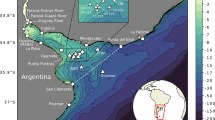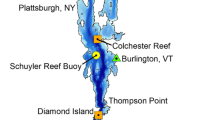Abstract
We describe the design, implementation, and performance of a fully automated Santos Operational Forecasting System (SOFS), built to monitor and predict short-term (< 3 days) sea surface elevations, currents, temperature, and salinity in the Santos-Sao Vicente-Bertioga Estuarine System (SSVBES). The SSVBES located at 24.0∘S, 46.3∘W is a complex estuarine system with many interconnected channels and two connections with the open sea. The system is prone to storm tides that bring coastal flooding to and interrupt ship traffic through Santos Port. The SOFS hydrodynamic module is based on the Princeton Ocean Model (POM) version POM-rain. The SSVBES model grid is forced by tides, winds, and river runoff and is nested into a coarse-resolution South Brazil Bight (SBB) grid. The SBB grid is forced by winds, density gradients, and the Brazil Current flowing offshore. Within SSVBES, SOFS works in parallel with three real-time observation stations. The model performance was tested against observed data with a best Willmott skill of 0.97 and root mean square error (RMSE) of 13.0 cm for tidal sea level (15.9% of the mean tidal range). For tidal currents, the best skill and RMSE were above 0.99 and 3.9 cm/s (4.3% of the mean tidal current range), respectively. The coupled system was able to simulate seven storm tides with average skill of 0.95 and average RMSE of 17.0 cm. The good agreement with observed data shows the potential use of the designed system to protect both human life and assets.















Similar content being viewed by others
Notes
Another way to obtain the storm surge signal is to subtract the predicted tide. However, the obtained time series would still be contaminated by the tidal signal, partially due to the remaining tidal components not considered in the tidal prediction performed with the 7 major constituents in the SSVBES (Section 2.4).
References
Alfredini P, Arasaki E, Pezzoli A, Arcorace M, Cristofori E, De Sousa WC Jr. (2014) Exposure of Santos Harbor Metropolitan Area (Brazil) to wave and storm surge climate changes. Water Qual Expo Health 6:73–88
Blumberg AF, Mellor GL (1987) A description of a three-dimensional coastal ocean circulation model. In: Heaps NS (ed) Three dimensional coastal ocean models, American Geophysical Union, Washington, pp 1–16
Campos EJD, Gonçalves J E, Ikeda Y (1995) Water mass characteristics and geostrophic circulation in the South Brazil Bight: summer of 1991. J Geophys Res 100(C9):18537–18550
Castro BM, Lee TN (1995) Wind-forced sea level variability on the southeast Brazilian shelf. J Geophys Res 100(C8):16045–16056
Castro BM, Miranda LB (1998) Physical oceanography of the Western Atlantic continental shelf located between 4N and 34S coastal segment. In: Robinson A R, Brink K H (eds) The Sea, vol 11. Wiley, New York, pp 209–251
Castro BM (2014) Summer/winter stratification variability in the central part of the South Brazil Bight. Cont Shelf Res 89:15–23
Copernicus Climate Change Service (C3S) (2017) ERA5: fifth generation of ECMWF atmospheric reanalyses of the global climate. Copernicus Climate Change Service Climate Data Store (CDS). https://cds.climate.copernicus.eu/cdsapp#!/home
Dottori M, Castro BM (2009) The response of the Sao Paulo Continental Shelf, Brazil, to synoptic winds. Ocean Dyn 59:603–614
Evans DL, Signorini SR (1985) Vertical structure of the Brazil Current. Nature 315:48–50
Fernández-Montblanc T, Vousdoukas MI, Ciavola P, Voukouvalas E, Mentaschi L, Breyiannis G, Feyen L, Salamon P (2019) Towards robust pan-European storm surge forecasting. Ocean Model 133:129–144
Georgas N, Blumberg AF, Bruno MS, Runnels DS (2009) Marine forecasting for the New York urban waters and harbor approaches: the design and automation of NYHOPS. In: 3Rd international conference on experiments/process/system modelling/simulation & optimization, Athens, vol 1, pp 345–352
Georgas N, Blumberg AF (2010) Establishing confidence in marine forecast systems: the design and skill assessment of the New York Harbor Observation and Prediction System, version 3 (NYHOPS v3). In: Eleventh international conference in estuarine and coastal modeling (ECM11), ASCE, Seattle, pp 660–685
Georgas N, Orton P, Blumberg A, Cohen L, Zarrilli D, Yin L (2014) The impact of tidal phase on Hurricane Sandy’s flooding around New York City and Long Island Sound. J Extreme Events 1(1):1450006
Georgas N, Blumberg A, Herrington T, Wakeman T, Saleh F, Runnels D, Jordi A, Ying K, Yin L, Ramaswamy V, Yakubovskiy A, Lopez O, McNally J (2016a) The Stevens Flood Advisory System: Operational H3E flood forecasts for the greater New York / New Jersey Metropolitan Region. Int J Saf Secur Eng 6:648–662
Georgas N, Yin L, Jiang Y, Wang Y, Howell P, Saba V, Schulte J, Orton P, Wen B (2016) An open-access, multi-decadal, three-dimensional, hydrodynamic hindcast dataset for the Long Island Sound and New York/New Jersey Harbor Estuaries. J. Mar. Sci. Eng. 4:48
Harari J, Camargo R (1998) Modelagem numérica da região costeira de Santos (SP). Rev Bras Oceanogr 46(2):135–156
Harari J, Camargo R, Cacciari PL (2000) Resultados da modelagem numérica hidrodinâmica em simulações tridimensionais das correntes de maré na baixada santista resultados da modelagem numérica hidrodinâmica em simulações tridimensionais das correntes de maré na baixada santista. Rev Bras Rec Hídric 5(2):71–87
Harari J, Camargo R (2003) Numerical simulation of the tidal propagation in the coastal region of Santos (Brazil, 24S 46W). Cont Shelf Res 23:1597–1613
Kodaira T, Thompson KR, Bernier NB (2016) The effect of density stratification on the prediction of global storm surges. Ocean Dyn 66:1733–1743
Liu Y, MacCready P, Hickey BM, Dever EP, Kosro PM, Banas NS (2009) Evaluation of a coastal ocean circulation model for the Columbia River plume in summer 2004. J. Geophys. Res. 114:C00B04
Marengo J, Muller-Karger F, Pelling M, Reynolds CJ, Merrill SB, Nunes LH, Paterson S, Gray AJ, Lockman JT, Kartez J, Moreira FA, Greco R, Harari J, Souza CRG, Alves LM, Hosokawa EK, Tabuchi EK (2017) An integrated framework to analyze local decision making and adaptation to sea level rise in coastal regions in Selsey (UK), Broward County (USA), and Santos (Brazil)). Am J Clim Chang 6:403–424
Mellor GL, Yamada T (1982) Development of a turbulence closure model for geophysical fluid problems. Rev Geophys Space Phys 20(4):851–875
Miranda LB, Castro BM (1998) Circulation and mixing due to tidal forcing in the Bertioga Channel, São Paulo, Brazil. Estuaries 21(2):204–214
Miranda LB, Olle ED, Bérgamo A L, Silva LS, Andutta FP (2012) Circulation and salt intrusion in the Piaçaguera Channel, Santos (SP). Braz J Oceanog 60(1):11–23
Miranda LB, Andutta FP, Kjerfve B, Castro BM (2017) Fundamentals of estuarine physical oceanography. Springer Nature, Singapore
Orton P, Georgas N, Blumberg A, Pullen J (2012) Detailed modeling of recent severe storm tides in estuaries of the New York City region. J. Geophys. Res. 117:C09030
Pawlowicz R, Beardsley B, Lentz S (2002) Classical tidal harmonic analysis including error estimates in MATLAB using t_TIDE. Comput Geosci 28:929–937
Pereira AF, Castro BM, Calado L, da Silveira ICA (2007) Numerical simulation of M2 internal tides in the South Brazil Bight and their interaction with the Brazil Current. J. Geophys. Res. 112:C04009
Prandle D, Wolf J (1978) Surge-tide interaction in the southern North Sea. In: Nihoul J C J (ed) Hydrodynamics of Estuaries and Fjords, Proceedings of the 9th Liege Colloquium on Ocean Hydrodynamics, Liege, vol 1977. Elsevier, Amsterdam, pp 161–185
Reid RO, Bodine BR (1968) Numerical model for storm surges in Galveston Bay. J Waterw Harb Div 94:33–58
Rezende JHM (2003) Intrusões da Ȧgua Central do Atlântico Sul na plataforma continental sudeste durante o verão. PhD thesis, University of São Paulo
Ribeiro RB, Sampaio AFP, Ruiz MS, Leitão J C, Leitão P C (2019) First approach of a storm surge early warning system for Santos region. In: Nunes L H, Greco R, Marengo P D J A (eds) Climate change in santos brazil: Projections, Impacts and Adaptation Options. Springer, pp 135–157
Signorini SR (1978) On the circulation and the volume transport of the Brazil Current between the Cape of São Tomé and Guanabara Bay. Deep-Sea Res 25:481–490
Silveira ICA, Schmidt ACK, Campos EJD, de Godoi SS, Ikeda Y (2000) A Corrente do Brasil ao largo da costa leste brasileira. Rev Bras Oceanogr 48(2):171–183
Silveira ICA, Calado L, Castro BM, Cirano M, Lima JAM, d S Mascarenhas A (2004) On the baroclinic structure of the Brazil Current-Intermediate Western Boundary Current system at 22∘–23∘S. Geophysical Res. Let. 31:L14308
Silveira ICA, Lima JAM, Schmidt ACK, Ceccopieri W, Sartori A, Francisco CPF, Fontes RFC (2008) Is the meander growth in the Brazil Current system off Southeast Brazil due to baroclinic instability? Dyn Atm Oceans 45:187–207
Smagorinsky J (1963) General circulation experiments with the primitive equations. Mon Weather Rev 91 (3):99–164
Walters RA, Heston C (1982) Removing tidal-period variations from time-series data using low-pass digital filters. J Phys Oceanogr 12(1):112–115
Willmott CJ (1981) On the validation of models. Phys Geogr 2(2):184–194
Zheng L, Chen C, Liu H (2003) A modeling study of the Satilla River estuary, Georgia. I: flooding-drying process and water exchange over the saltmarsh-estuary-shelf complex. Estuaries 26(3):651–669
Acknowledgment
The authors are thankful to REMARSUL project (CAPES, process 88882.158621/2014-01). The authors acknowledge CPTEC for providing the atmospheric fields used in this work. The authors also thank the CMEMS for making available the global ocean data and the ECMWF for the reanalysis data. This study has been conducted using E.U. Copernicus Marine Service Information.
Funding
The authors acknowledge financial supports from the Fundação de Amparo à Pesquisa do Estado de São Paulo (FAPESP, process 08/58101-9), the Conselho Nacional de Desenvolvimento Científico e Tecnológico (CNPq, process 310608/2014-7), the University of Sao Paulo through the Research Support Center - Sustainable Ocean (NAP-OceanoS), and the Office of Naval Research Global (ONR-G, process SPOOPS). This study was financed in part by the Coordenação de Aperfeiçoamento de Pessoal de Nível Superior - Brasil (CAPES) - Finance Code 001.
Author information
Authors and Affiliations
Corresponding author
Additional information
Responsible Editor: Fanghua Xu
This article is part of the Topical Collection on the 10th International Workshop on Modeling the Ocean (IWMO), Santos, Brazil, 25–28 June 2018
Rights and permissions
About this article
Cite this article
Costa, C.G.R., Leite, J.R.B., Castro, B.M. et al. An operational forecasting system for physical processes in the Santos-Sao Vicente-Bertioga Estuarine System, Southeast Brazil. Ocean Dynamics 70, 257–271 (2020). https://doi.org/10.1007/s10236-019-01314-x
Received:
Accepted:
Published:
Issue Date:
DOI: https://doi.org/10.1007/s10236-019-01314-x




